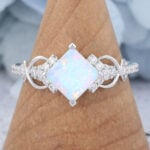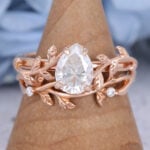Promise Ring vs Engagement Ring: When, Why, and How to Choose
Understanding the difference between promise ring and engagement ring is key to making a meaningful choice. Though both symbolize love, they carry different intentions and milestones. This engagement and promise ring guide breaks down everything you need to know about the promise ring vs engagement ring, helping you choose the one that best fits your relationship and future plans.
What Is a Promise Ring?
A promise ring, also called a commitment ring or courtship ring, is a meaningful symbol of loyalty and devotion in a relationship—this is the core of the definition of promise ring. It expresses faithfulness to a partner and a hopeful promise for the future, including the possibility of marriage.
Unlike traditional rings, a promise ring has no fixed style or strict rules. It can range from a simple metal band to a promise ring with diamonds or other gemstones made of silver, gold, or other materials. Because the true significance of a promise ring lies in the emotional commitment it represents, rather than its design or form.
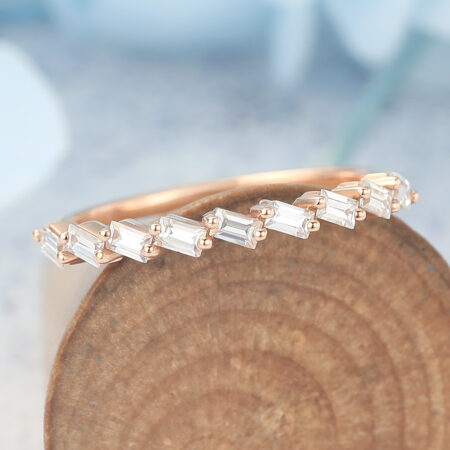
What Is an Engagement Ring?
An engagement ring, also known as a proposal ring, is a ring given during a marriage proposal to symbolize a lifelong commitment. It is most often presented by one partner to the other as a declaration of their intent to build a future together. More than just a piece of jewelry, it represents love, commitment, and responsibility.
Engagement rings typically feature a prominent center stone—often a large diamond or other precious gem—sometimes accented by smaller stones or set in a band made of gold, white gold, or platinum directly. Among these, diamonds have become the most popular choice due to their enduring symbolism of eternal and pure love.
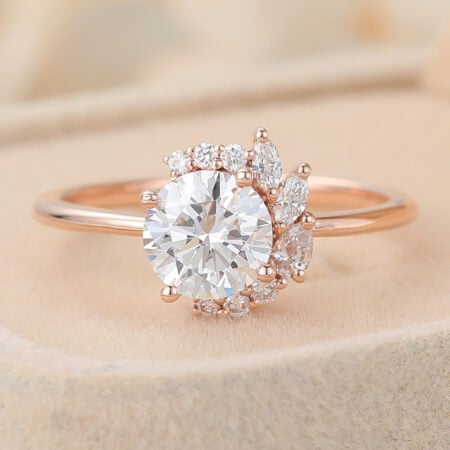
Promise Ring vs Engagement Ring: Key Differences
Meaning and Intent
The core meaning of a promise ring in a relationship is that it symbolizes the wearer’s sincere and unwavering emotional commitment to their partner. It not only expresses loyalty and dedication, but also provides stability and security, conveying hope and confidence in future mutual growth and progress. Overall, a promise ring is an important symbol of deeper emotional connection within a relationship.
In contrast, an engagement ring is a symbol of clear marriage intent. Often worn at a proposal, it signals the transition of a relationship into marriage. This ring not only represents the depth of love but also serves as a public commitment: it expresses “I’m willing to spend the rest of my life with you” and announces to those around you, “We’re engaged.” It carries a serious commitment to marriage, carrying a high degree of ritual significance.
Timing and Relationship Stage
When discussing the differences between a promise ring vs engagement ring, timing and the stage of the relationship are two key factors to consider. A promise ring is typically given during the earlier phases of a relationship, when the couple is not yet ready for a marriage commitment but wants to express loyalty and devotion in a meaningful and symbolic way. It represents a promise for the future, without necessarily implying that marriage is imminent.
In contrast, an engagement ring is given at a more mature point in the relationship—usually after thoughtful consideration and a mutual decision to get married. It signifies a clear intention to marry, and wearing one usually means that a proposal has taken place and a wedding is expected in the near future. Therefore, an engagement ring marks a stable or peak phase in the relationship, serving as a significant step from dating toward marriage.
Design and Style
Promise rings often feature a simpler and more delicate design compared to engagement rings. They are usually smaller in size and may use modest gemstones like small diamonds, birthstones, or symbolic shapes such as hearts or infinity signs. The focus is on personal meaning rather than opulence, making them suitable for everyday wear. Many promise rings are crafted in minimalist styles or set in sterling silver or 14k gold to reflect emotional sincerity rather than status.
Engagement rings are typically more elaborate and are designed to make a statement. They often feature a prominent center stone, most commonly a diamond, and are available in various settings like solitaire, halo, or three-stone designs. The style is usually chosen to reflect the wearer’s taste while symbolizing a major commitment. Materials like platinum or high-karat gold are commonly used, and the overall look aims to be luxurious and enduring, matching the long-term nature of the promise it represents.
Cost and Materials
Promise rings are typically more affordable than engagement rings, making them ideal for younger couples or those not yet ready for marriage. The promise ring cost can vary widely, but many opt for simple promise rings made with sterling silver, moissanite, or other lab-created stones. For those seeking a more unique touch, custom promise rings allow for personalized engravings, alternative gemstones, or symbolic designs without a high price tag.
Engagement rings generally involve a greater financial investment. Most feature diamonds set in gold or platinum, which significantly increases the cost. The emphasis is often on showcasing a central stone with more intricate settings, making engagement rings not just symbols of commitment but also heirloom-worthy pieces. In contrast to promise rings, the material and craftsmanship of engagement rings usually reflect a milestone step toward marriage.
Cultural Expectations and Traditions
Promise rings are often exchanged without the pressure of formal commitment. They represent love, loyalty, or personal promises, and are especially popular among young couples. Unlike engagement rings, promise rings aren’t tied to marriage proposals, so there are fewer cultural or family expectations.
Engagement rings hold deep cultural significance. In many societies, giving one marks the beginning of the marriage process. Expectations around timing, presentation, and family involvement are often stricter. From kneeling proposals to diamond-centered designs, engagement rings are steeped in tradition and symbolize a public declaration of lifelong intent.
Legal/Emotional Commitment Level
A promise ring is a symbol of a personal commitment, often representing loyalty, love, or a future intention to get engaged. It doesn’t carry legal weight and usually marks an early stage in a serious relationship.
An engagement ring signifies a formal proposal of marriage and a mutual intention to wed. While it has no legal power on its own, it is strongly tied to an emotional and socially recognized commitment to a future marriage.
When to Get a Promise Ring?
A promise ring is often given when a relationship becomes serious but before engagement is on the horizon. It’s ideal for couples who want to show long-term commitment, often after several months or a year of dating. There’s no fixed timeline—it’s about when both partners feel ready to symbolize their bond in a meaningful way.
What Hand and Finger Does a Promise Ring Go On?
The promise ring is most commonly worn on the ring finger of the left hand, similar to an engagement ring. This tradition reflects the romantic intention behind the gift. However, some people choose to wear the promise ring on the ring finger of the right hand to distinguish it from an engagement. So if you’re wondering what finger a promise ring goes on, both options are acceptable—promise ring placement depends on personal meaning and cultural habits. Ultimately, the promise ring finger is the one that feels most symbolic to your relationship.
Also Read: What Finger Does A Promise Ring Go On

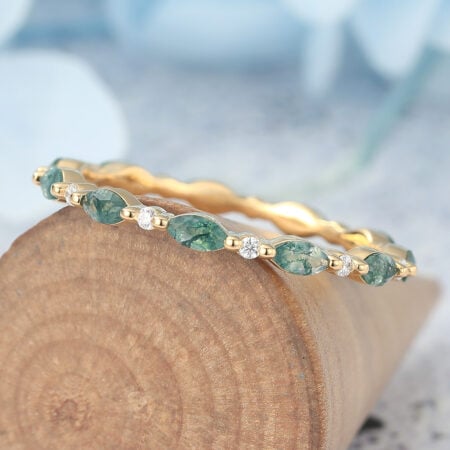
When to Get an Engagement Ring?
The right time to get an engagement ring depends on the couple’s relationship stage and mutual readiness for marriage. Some choose it after months of dating, while others wait years. What matters most is shared commitment and open conversations about the future.
What Hand and Finger Does an Engagement Ring Go On?
In most Western cultures, the engagement ring is traditionally worn on the fourth finger of the left hand, also known as the ‘ring finger’. This custom comes from the belief that a vein in this finger leads directly to the heart. However, some cultures place it on the right hand instead.
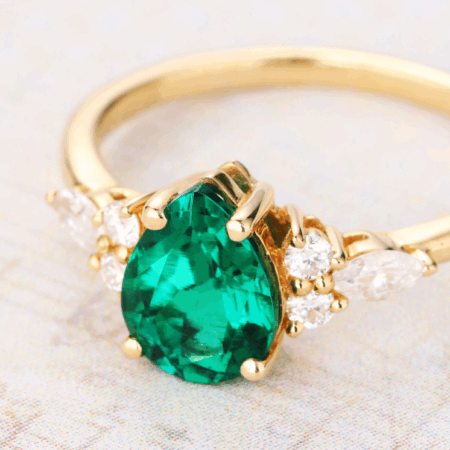
Promise Ring vs Engagement Ring: Can You Wear Both?
Yes, you can wear both a promise ring and an engagement ring, but how you wear them depends on personal preference and cultural norms. Often, the promise ring is worn on a different finger or hand to avoid confusion. Once engaged, some people move the promise ring to another finger or wear it alongside the engagement ring to honor both commitments.
Choosing the Right Ring: Factors to Consider
Selecting between a promise ring and an engagement ring depends on several personal factors. Consider the current stage of your relationship, your partner’s style preferences, and the message you want to convey. Budget also plays a key role, as engagement rings typically require a larger investment. Additionally, think about timing—whether you’re ready for a formal proposal or want to express commitment in a more casual way. Understanding these factors helps ensure you choose a ring that truly reflects your relationship and intentions.
Final Thoughts: Choosing the Right Ring for Your Love Story
Choosing between a promise ring vs engagement ring depends on your relationship’s stage and commitment. Both rings hold special meaning, so pick the one that best reflects your love and future together. The right ring is the one that truly tells your unique love story.
FAQs About Promise Ring vs Engagement Ring
No, promise rings for couples symbolize commitment but are not the same as engagement rings, which specifically represent a formal proposal and intent to marry.
Yes, some people use a typical promise ring as an engagement ring, especially if they prefer a simpler or more personal symbol.
A promise ring means a sincere commitment to a partner, often signifying exclusivity and hope for the future.
Promise rings generally cost less than engagement rings, with prices varying widely depending on materials and design.
Promise rings can be quite affordable, often made with modest stones or simple bands to keep costs reasonable.
A promise ring is defined by its purpose: it represents a vow or commitment between partners, not by a specific design.
Yes, a promise ring can be any ring chosen to symbolize a personal commitment, from simple bands to rings with gemstones.
The promise ring stage typically occurs before engagement, when couples want to express serious commitment without immediate marriage plans.
Promise rings are used to express loyalty, love, and future intentions between partners.
Yes, men also wear promise rings as symbols of their commitment.
Usually, a formal proposal involves an engagement ring, but some may use a promise ring to propose or as a step toward engagement.
Promise rings for couples show commitment without legal meaning; engagement rings signal a formal proposal; wedding rings represent a legal and lifelong marriage bond.


